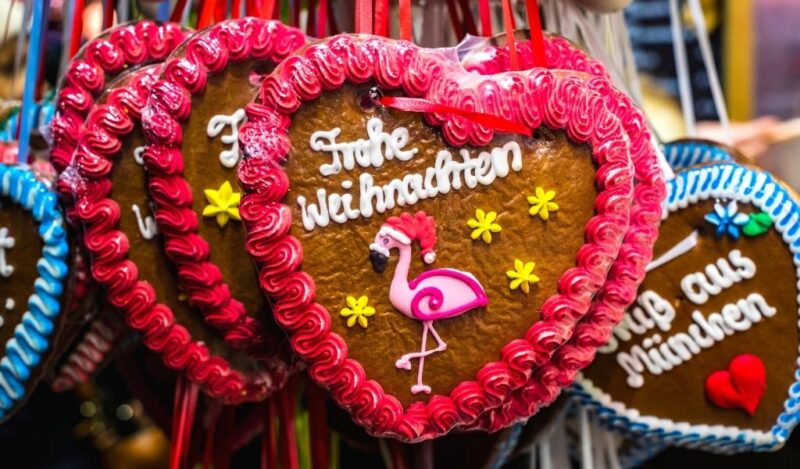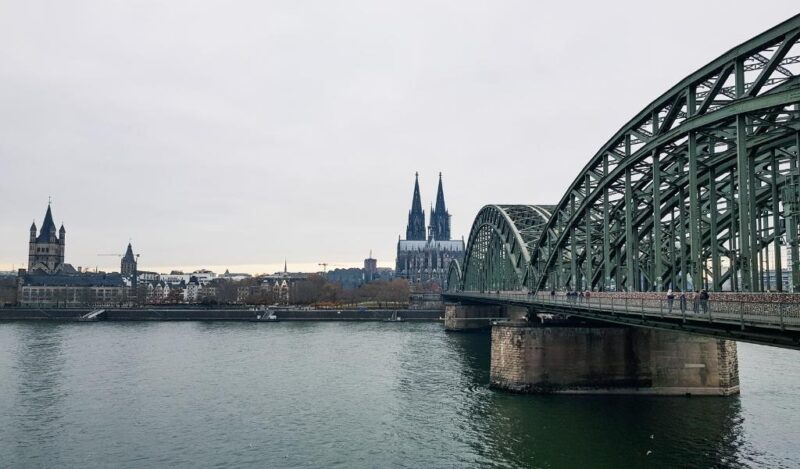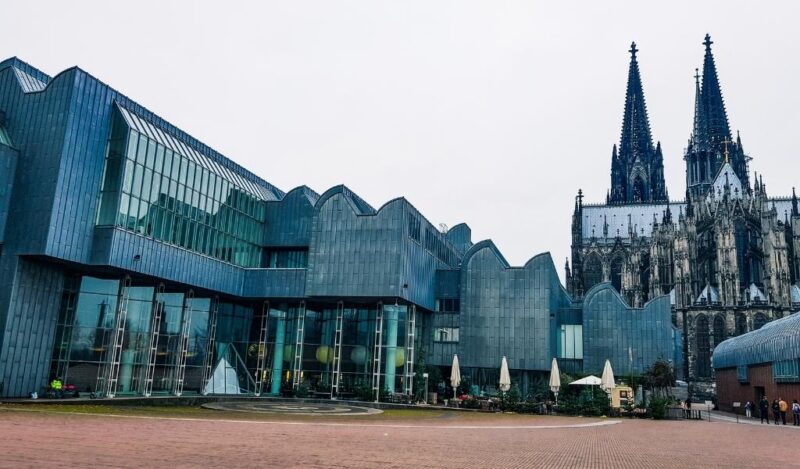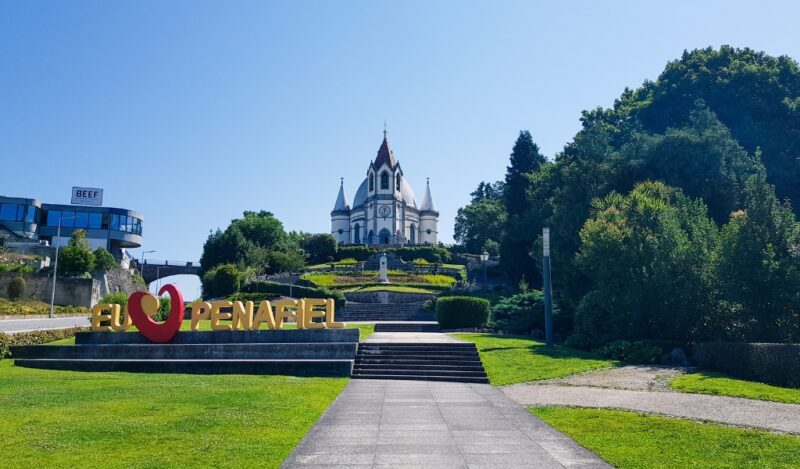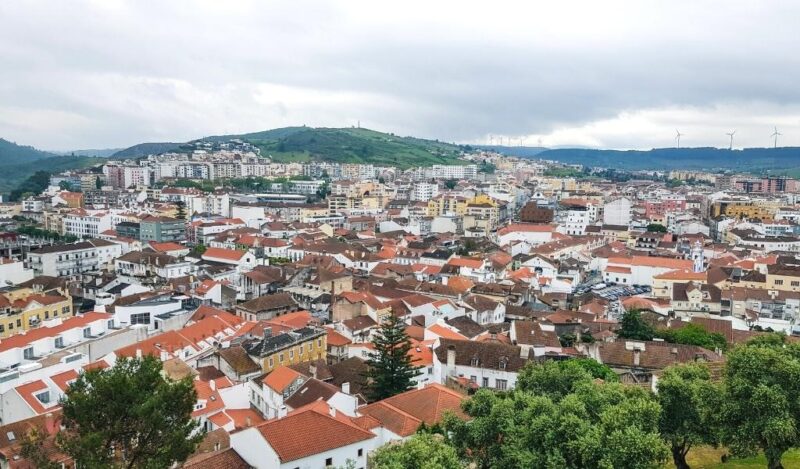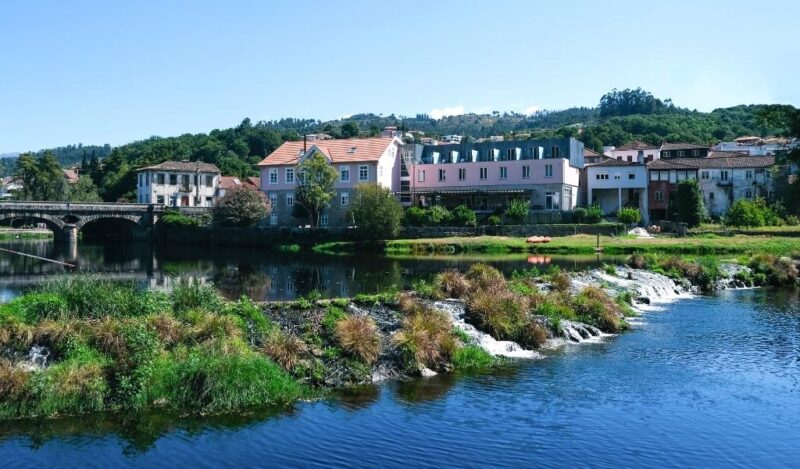Cologne (in German, Köln) is the main city in the German federal state of North Rhine-Westphalia and the fourth most populous city in Germany – right after the capital Berlin and the cities of Hamburg and Munich.
Besides, Cologne is located just a few kilometers from Germany’s borders with other European countries. For example, if you want to visit the cities of Liège or Maastricht – in Belgium and the Netherlands, respectively – you can do it in less than two hours (by car)!
So, do you want to know more about 2 Days In Cologne: The Perfect Cologne Itinerary? Keep reading!
This post may contain affiliate links, meaning I earn a small commission if you make a purchase, at no additional cost to you. Please read my disclosure & privacy policy for more information.
No time to read now? Pin it for later!


Brief History of Cologne
Did you know that Cologne is one of the oldest cities in Germany? Its origin dates back to the 30s BC when the Germanic tribe of the Ubii created the first urban settlement on the left bank of the River Rhine, which became known as the Oppidum Ubiorum.
In AD 50, the Romans founded a city, elevated to the capital of Lower Germania a few years later. They called it Colonia Claudia Ara Agrippinensium, in honor of Julia Agrippina the Younger (the wife of Emperor Claudius, born in this place).
In the following centuries, Cologne integrated the Gallic Empire, the Frankish Empire, and the Holy Roman-Germanic Empire – these last two, already in the Middle Ages and Modern Age. The city became also an important religious center, especially after 1164, when the alleged remains of the Three Kings were transferred to Cologne.

Its location on one of the main rivers associated with trade routes between Western and Eastern Europe led to the progressive growth of its population in the following centuries. Like many other European cities, Cologne was occupied by Napoleon Bonaparte’s troops during the French Invasions (between the late 18th and early 19th centuries).
With the defeat of France in 1814, Cologne and the rest of the Rhine region became part of Prussia. During World War II, most of the city’s infrastructure was destroyed by the bombings. The reconstruction of Cologne began in 1945 but was not completed until 1990, already after the Fall of the Berlin Wall.
Visiting Cologne
As I mentioned in the introduction, Cologne is situated very close to Germany’s borders with Belgium and the Netherlands. So you can use this German city as a starting point to get to know the neighboring Liège (in Belgium) or Maastricht (in the Netherlands), about 110-130 km away.
However, if you don’t want to cross land borders, you can always enjoy Cologne’s proximity to other German cultural centers, such as Bonn or Düsseldorf. The first is less than 30 km away, while the second is just over 40 km!
In my opinion, Cologne can be easily visited in one day, but the ideal itinerary requires two days. And if you manage to add another day (or two) to your stay, enjoy a day trip to Brühl to visit the Castles of Augustusburg and Falkenlust – which have been a UNESCO World Heritage Site since 1984 – or Phantasialand (an amusement park)!
Where to Stay in Cologne

BUDGET – Hostel die Wohngemeinschaft
The Hostel die Wohngemeinschaft is located in Neustadt-Süd, 1.7 km from the center of Cologne. The free wifi access, bar, and buffet breakfast are some of the most popular facilities.
The Hostel die Wohngemeinschaft has dormitories (with 6 or 8 beds) and rooms (single, double, triple, quadruple, and family).
BUDGET – Hotel Drei Kronen
The Hotel Drei Konen is situated in Altstadt-Nord, 250 m from the center of Cologne. The free wifi access, restaurant, and continental breakfast are some of the most popular facilities.
The Hotel Drei Konen has double and triple rooms, some of them overlooking the river.


MID-RANGE – Stadthotel am Römerturm
The Stadthotel am Römerturm is located in Altstadt-Nord, 0.8 km from the center of Cologne. The room service, restaurant, and continental or buffet breakfast are some of the most popular facilities.
The Stadthotel am Römerturm has rooms (single and double) and suites (junior).
MID-RANGE – Steigenberger Hotel Köln
The Steigenberger Hotel Köln is situated in Neustadt-Süd, 1.5 km from the center of Cologne. The room service, fitness center, and continental or buffet breakfast are some of the most popular facilities.
The Steigenberger Hotel Köln has rooms (twin and double) and suites.


LUXURY – Hyatt Regency Köln
The Hyatt Regency Köln is located in Deutz, 0.8 km from the center of Cologne. The swimming pool, bar, and parking are some of the most popular facilities.
The Hyatt Regency Köln has rooms (twin and double) and suites (executive).
LUXURY – Excelsior Hotel Ernst am Dom
The Excelsior Hotel Ernst am Dom is located in Altstadt-Nord, 150 m from the center of Cologne. The room service, fitness center, and spa are some of the most popular facilities.
The Excelsior Hotel Ernst am Dom has rooms (twin and double) and suites (junior and executive).

Cologne Itinerary – Day 1
Cathedral
The Cologne Cathedral (in German, Kölner Dom) is undoubtedly the most popular landmark of the city with the same name. The highest exponent of European Gothic architecture, the Cologne Cathedral is still the most visited church in Germany.
For that reason, I decided to write a post entirely dedicated to this Catholic temple, which has been a UNESCO World Heritage Site since 1996. This Cathedral is one of the mandatory stops on a Cologne itinerary and an excellent attraction to visit right at the beginning of your first day in the city!
Read my complete guide to the Cologne Cathedral, a must-see tourist attraction on any Cologne itinerary!
Roman-Germanic Museum
The Romano-Germanic Museum (in German, Römisch-Germanisches Museum) is located in one of the busiest squares in the city: the Roncalliplatz. Since I visited Cologne a few days before Christmas, the Romano-Germanic Museum went completely unnoticed by the dozens of food and craft stalls that were part of the city’s most famous Christmas Market!
Nevertheless, this archeology museum is one of the most important in Germany and worth a visit. Its collection is essentially made up of Romano-Germanic artifacts, recovered from the Roman city of Colonia Claudia Ara Agrippinensium. The site where the museum was built is an archaeological site since it preserves the ancient ruins of a Roman villa!


The Romano-Germanic Museum is open every day (except Tuesdays), from 10 am to 6 pm. However, its space is under renovation and the main exhibitions have been temporarily transferred to the Belgian House (in German, Belgischen Haus), at number 46 of the Cäcilienstraße.
Tickets costs €6 (adults) or €3 (reduced fare), and those under 18 years old don’t pay admission. Interestingly, two of the museum’s most important relics can be visited for free at the Roncalliplatz: the Dionysus Mosaic and the (Lucius) Poblicius Tomb.
Museum Ludwig
In this two-day itinerary in Cologne, the Museum Ludwig appears after the Romano-Germanic Museum, for reasons of geographic location and convenience. However, it’s understandable if you don’t want to visit the two museums in a row, so you can intercalate them with a walk on the Hohenzollern Bridge.
The Museum Ludwig is a gallery of modern and contemporary art. Several artistic movements that emerged in the last two centuries are represented here, with emphasis on the works of Abstractionism, Expressionism, Surrealism, and Pop Art.
Among the artists on display are names like Otto Dix, Roy Lichtenstein, and Andy Warhol. The Museum Ludwig is also known internationally for its collection of works by Pablo Picasso, the third-largest in the world (after the Picasso Museum in Barcelona and the Picasso Museum in Paris)!
The Ludwig Museum is open every day (except on Mondays), with different hours: on Fridays and Saturdays it operates from 10 am to 10 pm, but on the other days it closes two hours earlier (at 8 pm).
Tickets give access to permanent and temporary exhibitions and cost €11 (adults) or €7.50 (children, students, and trainees), and there’s also a special price for families at €26. Children under 6 years old don’t pay admission.
Hohenzollern Bridge
The Hohenzollern Bridge (in German, Hohenzollernbrücke) is probably the most popular tourist attraction in Cologne, right after its iconic Cathedral. Also known as Love Locks Bridge since 2008, it’s estimated that its “locks” weigh more than two tons!
The original bridge was built between 1907-11 to replace the Cathedral Bridge, which failed to serve the growing traffic at the Köln Hauptbahnhof train station. In addition, it was adapted for road traffic, making it one of the busiest bridges in Germany in the early 20th century.
Its name is a tribute to the House of Hohenzollern, the royal dynasty that ruled Cologne at that time. At each end, equestrian statues of Prussian kings and German emperors (or Kaisers) of the Hohenzollern family were erected, namely Frederick William IV of Prussia, William I of Germany, Frederick III, and William II.

But, did you know that the Hohenzollernbrücke was demolished during World War II and later completely rebuilt? When the Allied troops attacked Cologne, the German military engineers decided to blow up the bridge, to delay their land advances over the city!
With the defeat of Nazi Germany on May 8th, 1945, and the consequent end of World War II, the Hohenzollern Bridge started to be slowly rebuilt, serving only rail and pedestrian traffic, and was completed in 1959.
KölnTriangle
The KölnTriangle is an office skyscraper located in Deutz, a district of Cologne on the right bank of the River Rhine – which means, after the Hohenzollern Bridge. Formerly known as LVR Tower (in German, LVR-Turm), the building is just over 103 meters high and was completed in 2006.
The “Cologne Triangle” was designed by the German architect Dörte Gatermann and the project made her win national and international prizes and acclaim, especially for the innovative use of glass. For example, the south façade was built as a “double façade”, allowing for natural ventilation of all floors.
Currently, this 29-story skyscraper serves as the headquarters of the European Union Aviation Safety Agency, among other small companies. On the top floor, a glazed terrace offers panoramic views over the historic city center, making it the perfect place in Cologne to watch the sunset!
The KölnTriangle Viewpoint is open from Monday to Friday, from 8 am to 6 pm, and on Saturdays and Sundays, from 10 am to 3 pm. Tickets cost €5 (adults and youth) or €4 (pupils, students, and groups of five people). Children under 12 don’t pay admission.
Cologne Itinerary – Day 2
Fischmarkt
The second day of this itinerary in Cologne begins in a very photogenic area: the Fish Market (in German, Fischmarkt). This square is in the Old Town of Cologne (in German, Altstadt) and its origins date back to the beginning of the 12th century.

The famous colorful houses with pointed roofs are, in fact, reconstructions of the medieval buildings razed during the Second World War. Nowadays, the ground floors are dedicated to commercial street activities, with small shops, cafes, and restaurants.
In the center of the square, you’ll also find the Fisherwoman Fountain (in German, Brunnen der Fischweiber), created by the sculptor Rainer Walk.
Great St. Martin Church
The Klosterkirche Groß Sankt Martin, popularly shortened to Groß St. Martin, is a Romanesque church founded in the second half of the 10th century. Before that, there was a Roman chapel at this location.

The Great St. Martin Church has turned into a Benedictine monastery during the Middle Ages and the current structure emerged between 1150 and 1250. The monument is open from Tuesday to Friday, from 9:30 am to 7:30 pm, and on weekends, from 10 am to 7:30 pm.
Unfortunately, this Catholic temple was one of the most seriously damaged buildings in Cologne during World War II and the restoration work only ended in the 1980s!
Alter Markt
As I mentioned earlier, I visited Cologne before Christmas. This means that the main squares in the city were populated by the famous German Christmas Markets and street decorations.
This was the case with the Old Market (in German, Alter Markt), the largest square in the historic center of Cologne. Its first records date from the 10th century, when it was known as Mercatus Coloniae (ie, Cologne Market).

As far as is known, the first Cologne Christmas Market was held in 1820 at the Alter Markt. In 2018, the Alter Markt and Heumarkt’s Christmas Markets were named Heinzels Wintermärchen, in honor of the Heinzelmännchen (the gnomes in German folk tales).
Heumarkt
The Hay Market (in German, Heumarkt) is the second largest square in Cologne and is just a few meters from the Alter Markt. But did you know that these two markets were a single square until they were divided in the Middle Ages?
In the center of the Heumarkt, you’ll see an equestrian statue of King Frederick William III of Prussia, which was built between 1855 and 1878. The surrounding buildings are home to many restaurants and cafés.

The Heumarkt is still frequently used as a stage for concerts, shows, festivals, events, and other celebrations such as the Cologne Carnival.
The square is also close to the Deutz Suspension Bridge (in German, Deutzer Brücker), which connects the road traffic from Cologne’s Old Town to the homonymous district on the other side of the Rhine.
Chocolate Museum
Cologne Chocolate Museum (in German, Schokoladenmuseum Köln) was opened on October 31st, 1993 by Hans Imhoff, a renowned chocolate producer. Its permanent exhibition tells the story of chocolate, from the Mesoamerican civilizations of the Olmecs, Mayans, and Aztecs to the present day.
The Schokoladenmuseum is one of the most visited museums in Germany and has the famous Swiss chocolate maker Lindt & Sprüngli as a partner in the design of exhibitions, activities, and events since 2006. Some of the highlights of the visit are the cocoa trees’ greenhouse and the miniatures of chocolate-making machines. Visitors are also welcomed by a chocolate and sweets shop at the entrance and by a chocolate fountain, about three meters high!
Closed on Mondays, the Cologne Chocolate Museum is open from 12 pm to 6 pm (from Tuesday to Friday) and from 10 am to 6 pm (on Saturdays, Sundays, and holidays). However, tickets have different prices during the week and at weekends.
From Monday to Friday, they cost €12.50 (adults), €9 (students and apprentices), and €7.50 (children over 6 years old), while on Saturdays and Sundays they pay €13.50, €10, and €8, respectively. If you want, you can buy tickets in advance through the Cologne Chocolate Museum online ticket office.
Map of the Cologne Itinerary
Share this blog post on your social media!
More Posts about Germany
11 Best Christmas Markets In Germany (That You Should Visit This Year)
2 Days In Cologne: The Perfect Cologne Itinerary
How To Visit The Cologne Cathedral In 2024
More Posts about Travel Itineraries
1 Day In Penafiel: The Perfect Penafiel Itinerary
1 Day In Torres Vedras: The Perfect Torres Vedras Itinerary
2 Days In Arcos De Valdevez: The Perfect Arcos De Valdevez Itinerary
What Photography Gear Do I Use?
- Camera Body: Fujifilm X-T4 Mirrorless
- Camera Lens: Fujinon XF 18-55 mm F2.8-4 R LM OIS
- Tripod: Manfrotto Compact Action
- Small Tripod: Manfrotto PIXI Mini
- Smartphone Adaptor: Manfrotto PIXI Clamp
- Memory Card: SanDisk 128GB Extreme PRO SDXC

